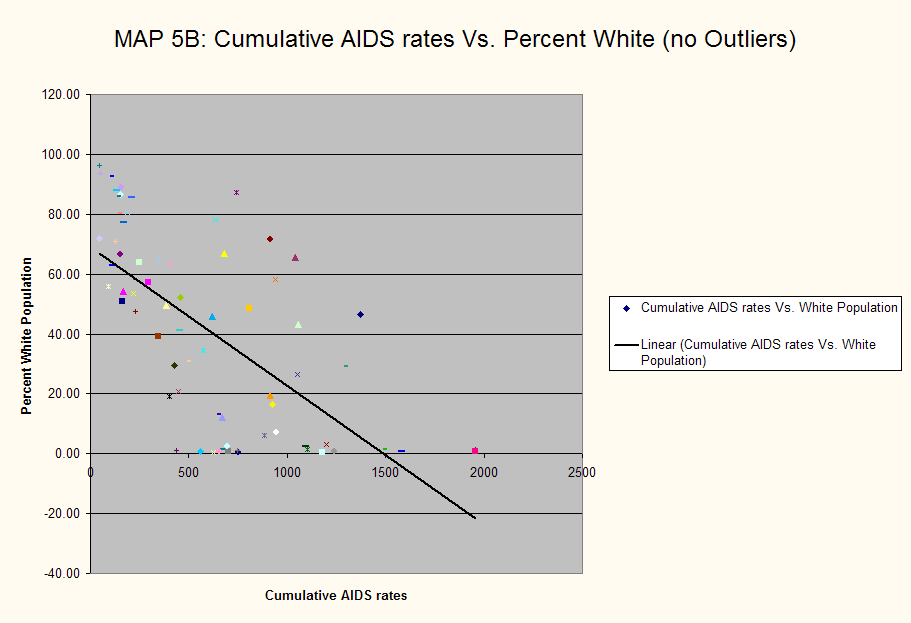INTRO: AIDS CORRELATION IN CHICAGO
RACE
Chicago is a diverse city most notably stratified by black and white communities. Over 80% of relocation families living in areas with an African American population greater than 90% and over 85% of these families live with a median income under $15,000 (7). But with blacks accounting for nearly 53 percent of AIDS cases in Chicago in 2005 (8) while representing only 37 percent of the Chicago population (9), it is no surprise that there is a significant correlation coefficient of 0.452 between the percent Black in each neighborhood and the AIDS rate. Conversely, the correlation coefficient between the percent white and cumulative AIDS rates is -0.415. The percent Hispanic and cumulative AIDS rates have a correlation of -.338, also negatively correlated (MAP G, GRAPH 7A, TABLE 5). The disparity between the percent of black populations and percent of Hispanic and white populations is reflected and solidified by geographic locations.
|
Area |
Black % With AIDS |
White % With AIDS |
Hispanic % With AIDS |
|
Chicago |
56% |
29% |
15% |
|
Illinois |
49.8% |
36.4% |
313 |
|
U.S. |
40.9% |
40.6% |
609.92 |
Conversely, wards with the lowest cumulative AIDS rates are predominately white and in the north. Edison Park, Jefferson Park and Norwood Park are three neighboring areas in the north with extremely high white populations and low cumulative AIDS rates. After studying the scatter plot graphs, however, Uptown and two neighboring wards, Lakeview and Edgewater, severely affect the outcome of most of the correlation coefficients. This is mostly because they are predominately white, gay neighborhoods with astronomical cumulative AIDS rates: Uptown has a cumulative AIDS rate of 3106, Lakeview has a cumulative AIDS rate of 2118, and Edgewater has a cumulative AIDS rate of 2047 (TABLE 2, MAP A/E). As these contain the majority of the gay population- the leading risk-group during the early stages of the AIDS epidemic, these three neighborhoods will continue to be outlying factors that skew correlations of the worsening AIDS epidemic in wards heavily populated by African Americans. When three northern wards: Uptown, Edgewater, and Lakeview, are removed from the correlational analysis, the coefficients for the White and Black percent per neighborhood with AIDS cases changes dramatically. The percent white and AIDS cases adjusts from -0.415 to -0.654 whereas the percent black and AIDS cases jumps from 0.452 to 0.68 (TABLE 6). Furthermore, disregarding the predominately white, gay neighborhoods, two of the three wards with the highest cumulative AIDS rates are adjacent areas with the highest percent of blacks; Washington Park is 98.1 percent black and Grand Boulevard is 98.2 percent black. Neighboring wards, Great Grand Crossing, Grand Boulevard, and Oakland, have black percentages that exceed 98.0 percent as well and are among ten wards with the highest cumulative AIDS rates in Chicago (TABLE 6)

